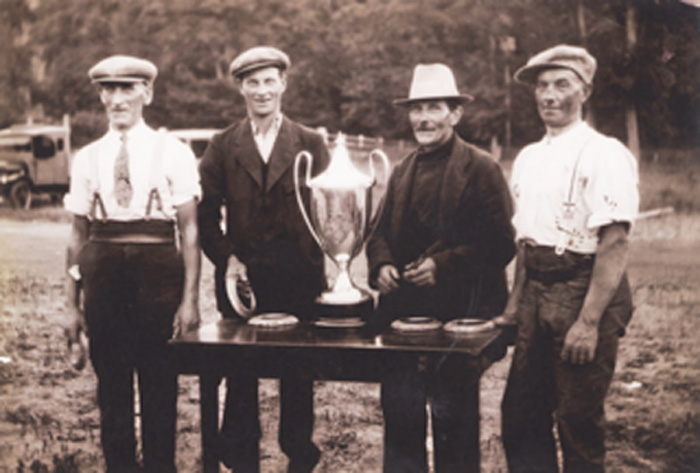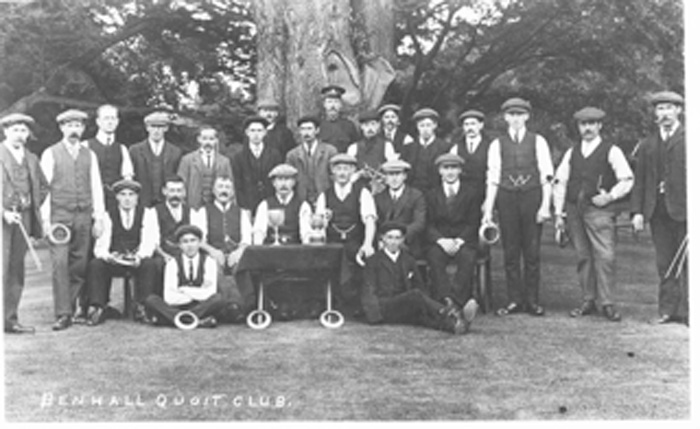- Screen Colours:
- Normal
- Black & Yellow
A Question of Quoits
The magnificentsolid silver cup pictured is the Lord Rendlesham Cup, and the proud winners in 1932 were the Benhall Quoits Team. They are -Paternoster, - Brightwell, - Blake and William Burch - other Christian names unknown. The photograph below, of the village quoits team of 24 men, is thought to date from before the First World War. The Cup itself may also date from that era.

Benhall still fields a team in this traditional trial of skill and strength, and they now play out of the Golden Hind in Ipswich. The clay beds, which lay beyond the car park at the village Memorial Club, have recently been demolished. Suffolk teams continue to compete annually for the Lord Rendlesham Cup, which is kept at Hollesley Bay Museum. The Benhall team won the Cup again for the village at the Benhall Flower Show one year, probably in the 1950s. If you know which year that was, or have a photograph of the winning team, the History Group would love to hear from you. Please contact the Secretary, Karen Howman, on 01728 605709.
Photograph kindly loaned by Henry and Dora Burch; information kindly supplied by Graham Smith, material compiled by Brenda and Eve of the History Group, with a little help from the internet.
More About Quoits
This ancient game of tossing a metal ring at a target embedded in soft clay has been played in the UK since medieval times. It was first mentioned in 1388 when it was listed as a prohibited game under the Sporting Regulations Act. Why the authorities should want to suppress this apparently harmless pastime is a mystery, but it survived and flourished, especially in agricultural and mining communities. Teams were often based in the village pub and competitions were held at fairs and festivals. Quoits remained very local in character and to this day there are no national rules or national competitions. The game varies from one region to another. There is the Northern Game, played mainly in Yorkshire, Northumberland and Cumberland, with an 11 yard pitch and quoits weighing five-and-a-half pounds. In Scotland and Wales the Long Game (also called the Old Game) is played. There is a different version in Northern Ireland.
Suffolk teams play a version of the Long Game. Here, the pitch is 18 yards long, the bed is three feet in diameter and six inches high, the target pin, which is set flush with the clay, is no more than five-eights of an inch in diameter. The pair of quoits weighs seven-and-a-quarter pounds, being seven-and-a-quarter inches in diameter. The game has its own vocabulary - the toe bed,the ringer, the cover, and much, much more. Matches are held from May to September.
The origins of the game are lost in time. Some claim it began in Greece, and is akin to throwing the discus, which means it could go back to the first Olympic Games; others are content to see its origins in the humble art of pitching horseshoes - a game still played in the USA. Yet another theory is that it began in India, with the Sikhs, who used metal throwing rings as weapons. There are,of course, many variations of the traditional Quoits (both Old and Northern). The more genteel Lawn (or Sward) Quoits is played with pegs and rings, suitable for the less brawny and not requiring the maintenance of special clay beds; Deck Quoits has been a popular pastime on the decks of ocean liners and there are also many forms of Indoor Quoits.
